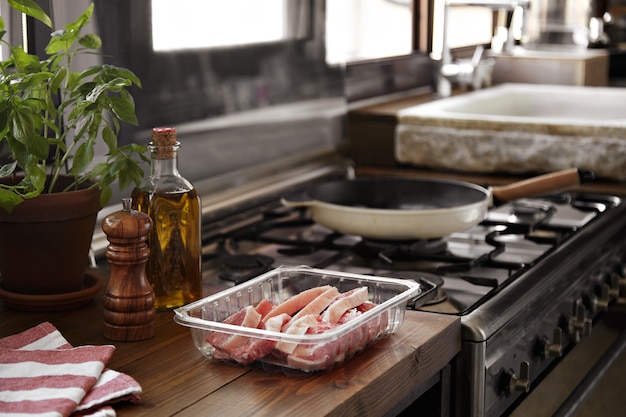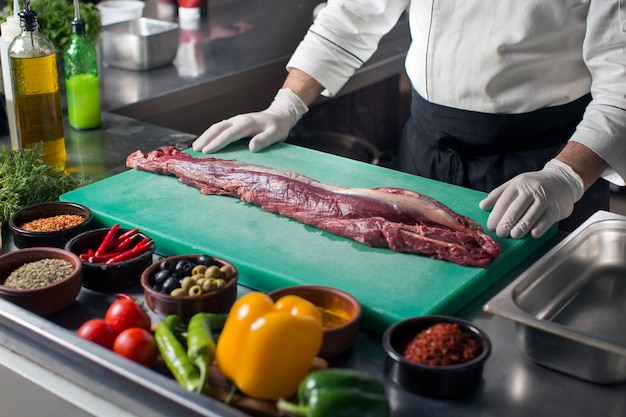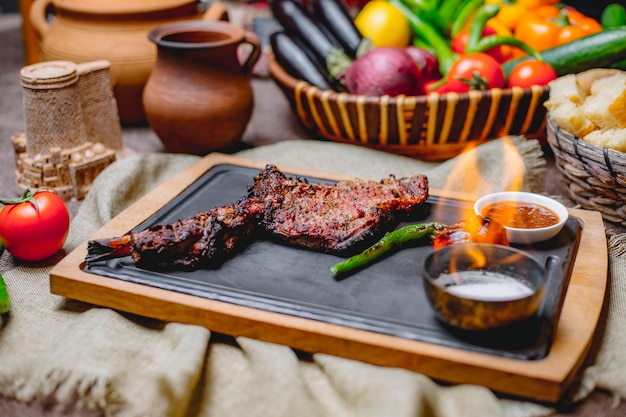Ah, prime rib. The mere mention of it conjures up images of a grand feast, a special occasion, or a comforting Sunday dinner shared with loved ones. This magnificent cut of beef holds a special place in my heart, and over the years, I've dedicated myself to crafting the perfect prime rib recipe. It's not just about the meal itself, but the experience it creates, a testament to the magic of slow cooking and the sheer joy of good food. So, let's embark on this culinary adventure together, and I'll share my secrets to achieving that melt-in-your-mouth, juicy, and flavourful prime rib that will have everyone begging for seconds (and thirds!).
(Part 1) The Prime Rib: A Cut Above the Rest

The star of our show, of course, is the prime rib itself. It's not just any piece of beef; it's a cut from the rib section, specifically the 7th to the 12th ribs, making it a truly impressive centerpiece. The secret to a truly sensational prime rib lies in selecting the right cut. My personal preference is a bone-in standing rib roast, ideally a "prime" grade. Why? The bone acts as a natural insulator, keeping the meat moist throughout the cooking process. Additionally, "prime" grade beef guarantees a beautiful marbling of fat, which adds incredible flavour and tenderness. But don't despair if you can only find "choice" grade - as long as it has a good amount of fat marbling, it will still be delicious.
Understanding the Cut
When you're at the butcher's counter, ask for a standing rib roast. They should be able to provide you with the weight you desire. For a typical family dinner, I recommend a roast weighing 3-4 kg. If you're cooking for a larger gathering, go for a bigger one. You can also ask the butcher to tie the roast for you, which helps keep its shape during cooking.
Tips for Choosing the perfect prime rib
- Fat Marbling: Look for a roast with a good amount of fat running throughout the meat. This indicates it will be juicy and flavourful.
- The Bone: Choose a bone-in roast. As mentioned, the bone helps keep the meat moist while cooking.
- Uniform Shape: Look for a roast that is fairly uniform in shape. This will ensure that it cooks evenly.
(Part 2) Preparing the Prime Rib

Once you've got your magnificent prime rib in hand, the real fun begins. It's time to get your hands dirty and prepare it for its grand entrance into the oven. Now, I know some folks swear by elaborate rubs and marinades, but I'm a firm believer in simplicity. A good, basic seasoning is all this prime rib needs to shine.
The Art of Simple Seasoning
My go-to seasoning is a blend of salt, pepper, garlic powder, and onion powder. It's a classic for a reason. You can also add other herbs and spices to taste, like rosemary, thyme, or paprika. This is where you can get creative and personalize your roast, tailoring it to your taste and the occasion.
Essential Preparation Steps
- Pat it Dry: Before seasoning, pat the roast dry with paper towels. This will help prevent steaming during cooking and allow the seasonings to adhere properly.
- Generous Seasoning: Season generously with your chosen spice blend. Don't be shy! Remember to rub it right under the skin for extra flavour.
- Rest is Key: Let the roast rest at room temperature for at least 30 minutes before cooking. This will help it cook more evenly.
(Part 3) The Oven: A Culinary Stage

Now, it's time to unveil the big gun - your trusty oven. This will be the stage where your prime rib will transform into a culinary masterpiece. Before we set the stage, preheat your oven to a blazing 230 degrees Celsius (450 degrees Fahrenheit). This high initial temperature is vital for creating a beautiful, crispy crust, locking in those precious juices, and giving your roast a gorgeous sear.
Temperature Control for the Perfect Roast
After that initial burst of high heat, you'll lower the oven temperature to 120 degrees Celsius (250 degrees Fahrenheit). This slower, gentler heat ensures the roast cooks evenly and reaches your desired level of doneness without drying out. It's a bit of a balancing act, but trust me, it's worth the effort. It's all about achieving that perfect balance of crispness on the outside and juicy tenderness on the inside.
cooking time: A Guiding Principle
The amount of time your prime rib spends in the oven will depend on its size. A good rule of thumb is about 15 minutes per 500 grams (1 pound) of meat for medium-rare. So, a 3 kg roast would need about 90 minutes. However, remember that every oven is different, so it's always a good idea to use a meat thermometer to check the internal temperature.
(Part 4) The Rest: The Secret to Tenderness
Once your roast has reached the desired internal temperature, it's absolutely crucial to let it rest before carving. This is a step many people overlook, but it's the key to achieving that melt-in-your-mouth tenderness we all crave. Allow the roast to rest, covered with foil, for at least 15 minutes. This allows the juices to redistribute throughout the meat, resulting in a more tender and flavourful final product.
(Part 5) The Internal Temperature: Doneness Done Right
One of the most important parts of cooking a perfect prime rib is getting the internal temperature just right. You can use a meat thermometer to ensure your roast is cooked to your preference. Here's a quick guide to different levels of doneness:
Doneness Guide
| Doneness | Internal Temperature (°C) | Internal Temperature (°F) |
|---|---|---|
| Rare | 46-49 | 115-120 |
| Medium-Rare | 52-57 | 125-135 |
| Medium | 60-65 | 140-150 |
| Medium-Well | 68-71 | 155-160 |
| Well Done | 74 | 165 |
(Part 6) The Carving: An Artful Presentation
After that glorious rest, the anticipation is building. It's finally time to carve that beautiful prime rib. Carving is an art form in itself, a way to showcase the juicy, pink meat and the magnificent bone structure. It's best to carve against the grain, which will ensure the most tender slices.
Mastering the Art of Carving
- Sharp Knife is King: A sharp carving knife is essential for clean, precise cuts. A dull knife will result in uneven slices and may even tear the meat.
- Carving Against the Grain: This will help to ensure that the slices are tender and easy to chew. The grain of the meat runs along the length of the roast, so carve perpendicular to it.
- Presentation Matters: Arrange the carved meat attractively on a platter. You can use a carving board with a built-in well to catch the juices, or simply use a large platter.
(Part 7) Accompaniments: The Perfect Pairings
No prime rib feast is complete without a selection of delectable accompaniments. I love pairing my prime rib with classic sides that complement the rich flavour of the meat. These are my tried-and-true favourites:
side dish Inspiration: A Symphony of Flavours
- Roasted Potatoes: Crispy on the outside, fluffy on the inside, these are a perfect match for the richness of the prime rib. You can roast them with herbs, garlic, or even a bit of rosemary for an extra burst of flavour.
- Asparagus: Roasted or steamed, asparagus adds a fresh, vibrant counterpoint to the hearty meat. A drizzle of lemon juice and a sprinkle of salt and pepper will enhance the asparagus' natural flavours.
- Yorkshire Pudding: This traditional British side dish is a perfect vessel for the juices from the prime rib. It's a delightful combination of crispy edges and fluffy insides, making it a wonderful complement to the meat.
- Creamed Spinach: This creamy, comforting side pairs beautifully with the meat. It's a classic for a reason, offering a touch of richness and a lovely green hue to the table.
- Gravy: No prime rib is complete without a rich, flavorful gravy. You can make your own from scratch using the pan drippings, or use a store-bought version. The key is to create a gravy that complements the flavour of the meat.
(Part 8) The Final Touches: Elevating the Experience
Now, it's time to add those finishing touches that will turn a simple meal into a truly memorable experience. A drizzle of red wine sauce, a sprinkle of fresh herbs, or a dollop of horseradish cream can elevate the prime rib to new heights.
Elevating the Prime Rib Experience: Finishing Touches
- Red Wine Sauce: A rich, flavorful sauce made from red wine, beef stock, and herbs. This is a classic pairing for prime rib, adding depth of flavour and a touch of elegance to the dish.
- Fresh Herbs: Chopped parsley, rosemary, or thyme can add a touch of freshness and a burst of flavour to the prime rib. Use them sparingly, letting the flavours of the meat shine through.
- Horseradish Cream: A tangy and spicy cream that is a classic accompaniment to prime rib. This provides a contrasting flavour and adds a touch of heat to the rich meat.
(Part 9) FAQs: Answering Your Prime Rib Questions
So, are you ready to embark on your own prime rib journey? Fantastic! But I know you might have a few questions. Don't worry, I've got you covered. Here are some frequently asked questions and my expert advice:
1. Can I Marinate Prime Rib?
Absolutely! Marinating your prime rib can add extra flavour and tenderness. A simple marinade of red wine, olive oil, garlic, and herbs can do wonders. However, it's not essential. The flavour of the prime rib itself is pretty spectacular! If you do choose to marinate, remember to pat the roast dry before seasoning and cooking.
2. How Long Should I roast prime rib?
The roasting time will depend on the size of your roast and the level of doneness you desire. A general rule of thumb is about 15 minutes per 500 grams (1 pound) of meat for medium-rare. However, the best way to know when your prime rib is done is to use a meat thermometer. It will provide an accurate reading of the internal temperature, ensuring your roast is cooked to perfection.
3. What Happens if I Overcook Prime Rib?
Overcooked prime rib can become dry and tough. It's best to err on the side of undercooking, as you can always cook it a little longer if needed. But once it's overcooked, there's not much you can do to salvage it. It's always better to be safe than sorry, and to ensure your prime rib is juicy and tender, it's best to aim for a slightly undercooked state.
4. Can I Freeze Prime Rib?
Yes, you can freeze prime rib for up to 3 months. Thaw it in the refrigerator for 2-3 days before cooking. Just make sure you wrap it tightly in plastic wrap or foil to prevent freezer burn. This will help to maintain the quality and flavour of the meat.
5. What Kind of Wine Goes Best with Prime Rib?
A full-bodied red wine, such as Cabernet Sauvignon, Merlot, or Zinfandel, is a perfect pairing for prime rib. The rich tannins in these wines complement the flavour of the meat, creating a harmonious balance of taste. Consider the specific flavours of your prime rib seasoning when choosing your wine, and look for a wine that will enhance, not overpower, the overall flavour profile.
(Part 10) The Conclusion: A Culinary Triumph
And there you have it! My ultimate guide to prime rib, a dish that's guaranteed to impress your guests and leave them craving for more. Remember, it's not just about the recipe; it's about creating an experience, a shared moment of enjoyment with loved ones. So, go ahead, embrace the challenge, and create your own culinary triumph. You'll be amazed at how simple it is to cook a truly remarkable prime rib. The reward is a delicious and satisfying meal that will become a favourite in your household.
Everyone is watching

Prime Rib Roast Cooking Time Chart: Per Pound Guide
Cooking TipsPrime rib roast. Just the name conjures images of lavish dinners, crackling fires, and hearty laughter. It’s ...

How Long to Bake Potatoes in the Oven (Perfect Every Time)
Cooking TipsBaked potatoes are a staple in my kitchen. They're incredibly versatile, delicious, and surprisingly easy to m...

Perfect Rice Every Time: The Ultimate Guide to Cooking Rice
Cooking TipsAs a self-proclaimed foodie, I've always been a bit obsessed with rice. It's the foundation of countless cuisi...

The Ultimate Guide to Cooking Asparagus: Tips, Techniques, and Recipes
Cooking TipsAsparagus. The mere mention of this spring delicacy conjures up images of vibrant green spears, crisp and burs...

Ultimate Guide to Cooking the Perfect Thanksgiving Turkey
Cooking TipsThanksgiving. Just the word conjures up images of overflowing tables laden with delicious food, the scent of r...
